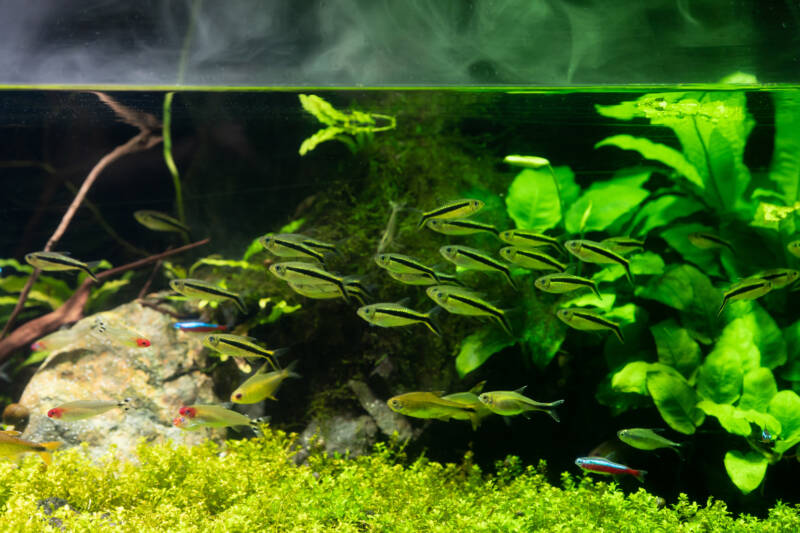Tetras are a popular go-to for adding neon color to any aquarium. With over 150 different tetra fishes to choose from, fishkeepers of any experience level, or tank size can find the perfect fit.
And due to their easy-going personality, they can live with many other fish, including other tetras.
Tetra fish are incredibly hardy, and not hard to keep alive, putting them at the top of the list for a beginner friendly option.
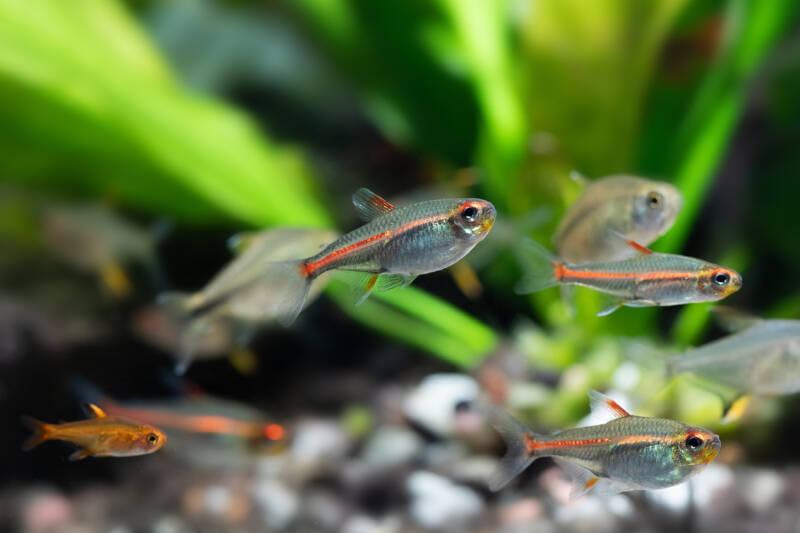
They are a freshwater, warmer climate species, rarely growing larger than 2.5 inches (6.4 cm) – at least for the most popular aquarium types.
Tetras set themselves apart with a fourth set of paired fins! (most fish only have three) The fourth adipose pair rests between the caudal and dorsal fins. As a matter of fact, the name “tetra” comes from the Greek word for “four.”
Fun Tetra Fact:
Check out 39 popular tetra fish types below:
[toc]
If you can imagine a color, pattern, or shape, odds are there’s a type of tetra to match your dream. Even the iconic GloFish® comes in tetra form.
While you CAN combine different types of tetras without a problem, keep in mind that all tetras are schooling fish. This means you need an appropriately sized tank.
For each tetra you add to your aquarium, you need an additional 2 gallons or 7.5 liters of space.
1. Emperor Tetra
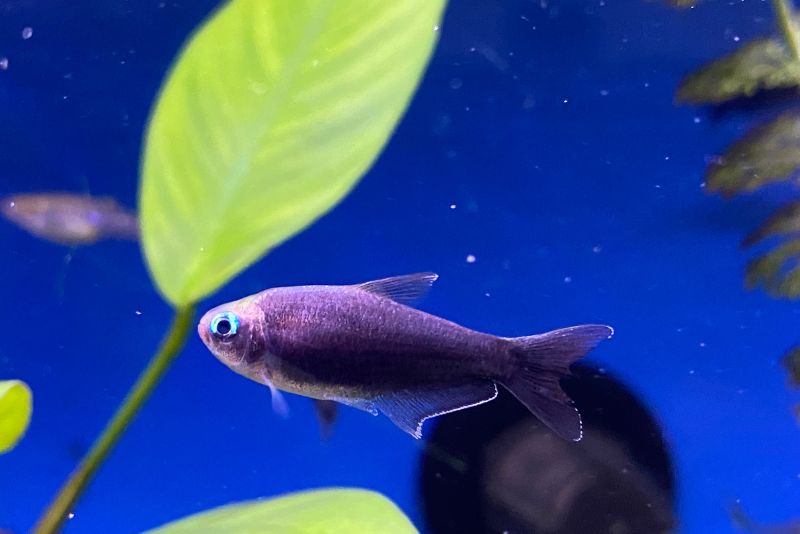
- Difficulty: moderate
- Temperament: peaceful
- Diet: omnivore
- Tank Size: 10 gal (37 l)
Set against dark substrates and decor, Emperor tetras (Nematobrycon palmeri) stand out in a crowd.
They have a dark stripe following the lateral line – something common among several tetra species – but they add in touches of red, yellow, and blue when they swim around and catch the light.
Emperors also stand out from other tetras in their sexual dimorphism. Males have longer dorsal and caudal fins that come to sharper points. And the central ray of the caudal tail extends out, forming a prominent “trident” appearance.
You do need to make sure you mimic their native waters from Colombia.
And since they prefer slower water currents, you’ll want to choose your filters with care. Too much outflow and they’ll duck into hiding out of stress.
2. Ember Tetra
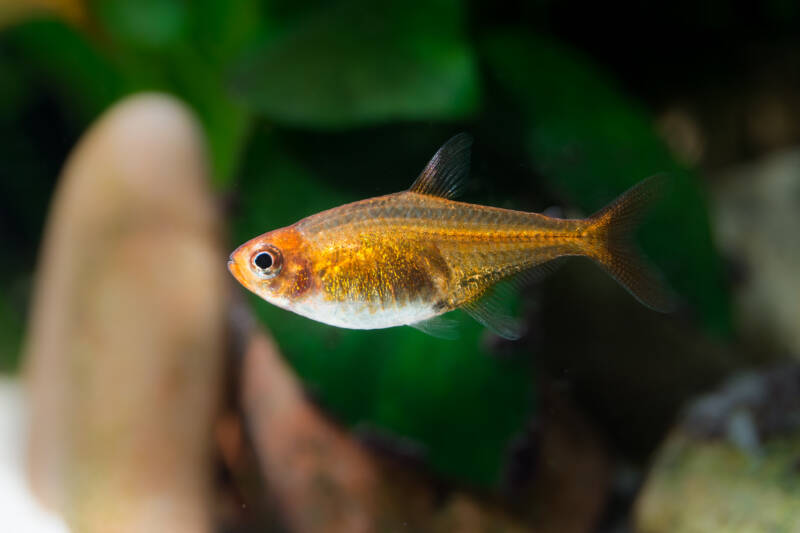
- Difficulty: easy
- Temperament: peaceful
- Diet: omnivore
- Tank Size: 10 gal (38 l)
As you might guess, Ember tetras (Hyphessobrycon amandae) have a bright orange coloration to suit their name. Their skin is relatively thin, appearing almost transparent. The combination makes for a striking addition, especially in a planted aquarium.
Ember tetras are playful little fish. They only reach around 1 inch (2.5 cm) in length. However, they swim in tightly packed schools, so the more you keep, the better the effect.

Make sure there’s a nice balance between the swimming room and plants to hide in.
Embers have personalities MUCH bigger than their tiny size. You might notice them trying to convince you into dropping extra food into the tank. Be careful not to fall for the trick and overfeed your ember tetras. You’ll end up with significant health problems.
3. Pristella Tetra or X-Ray Tetra
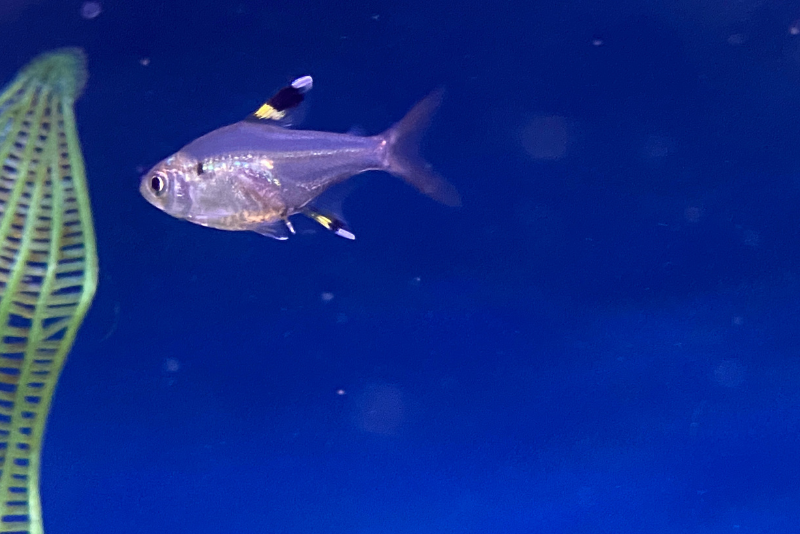
- Difficulty: easy
- Temperament: peaceful
- Diet: omnivore
- Tank Size: 10 gal (38 l)
X-ray tetras – more commonly known as Pristella tetras (Pristella maxillaris) – get their name from the slight translucency of their scales.
You can almost see the internal structures within the body if you look closely. Otherwise, there’s a distinct black stripe across the dorsal fin.
X-rays have a Weberian apparatus. You see similar structures in catfish, and when combined with the swim bladder, the individual pieces allow the fish to pick up sound waves through the water. It makes them champs at avoiding approaching predators.

Of course, you’ll still want to set up a tank with appropriate shoal numbers. At least six x-ray tetras should do the trick. When confronted with too few school members – or too many larger tank mates – they’ll get nervous and duck into hiding.
4. Rummy Nose Tetra
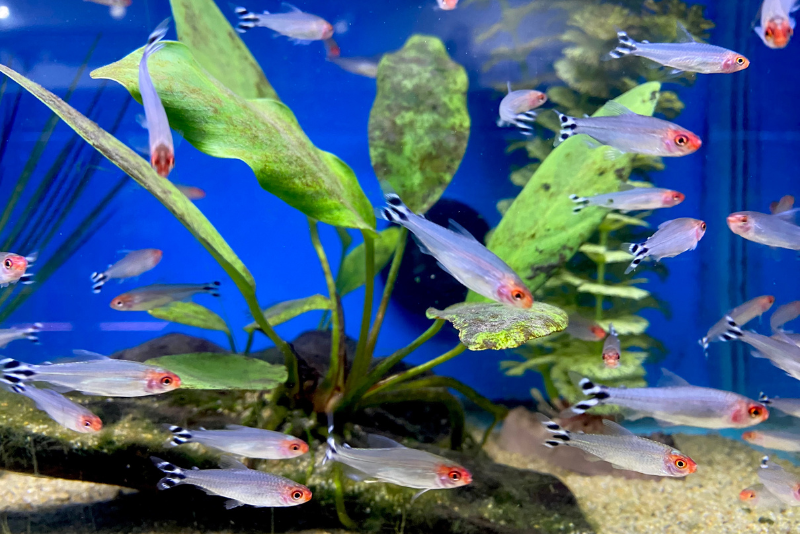
- Difficulty: moderate
- Temperament: peaceful
- Diet: omnivore
- Tank Size: 20 gal (75 l)
Rummy Nose tetras (Hemigrammus rhodostomus) earned their name from the red coloration over their heads. The remainder of the fish features a silvery body on tightly packed scales that flash under the lights, terminating in a mixture of black and white patterning on the tail.
For people looking for a type of tetra that’s a little larger, rummy noses fit the bill. Once full-grown, they reach lengths of 2.5 inches (6.4 cm).
They also have one of the longer lifespans for a tetra, living approximately eight years.
You should anticipate getting a school of at least six fish to prevent stress in the group. It’ll be worth the expense, though. Rummy nose tetras swim in unison within their schools, creating elaborate displays within the tank.
If you are lucky you can find the Albino Rummy Nose tetra which has an ivory white body with a pink nose.
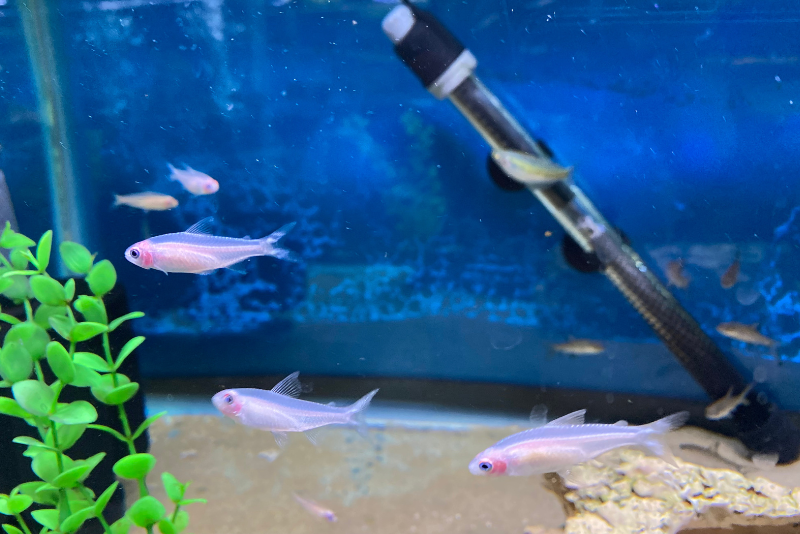
5. Crystal Tetras
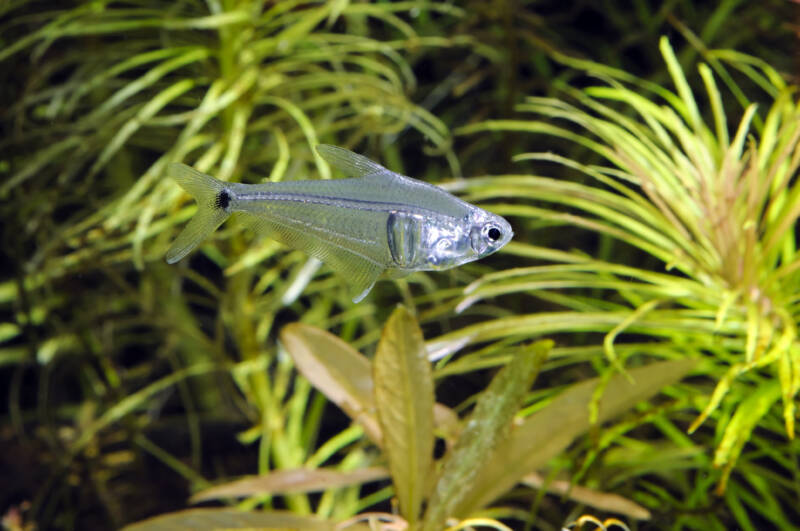
- Difficulty: moderate
- Temperament: peaceful
- Diet: omnivore
- Tank Size: 10 gal (38 l)
The Crystal Tetra (Protochelrodon pl.) is fully transparent, including the fins, and covered in tiny black dots. You can see its uniquely divided swim bladder that forms the shape of the Greek letter pi.
These fish can be somewhat shy and skittish. Keeping them in large groups of at least ten will increase their comfort level and lead to more natural behavior.
They favor the middle region of the water column. When selecting tank mates, avoid species that occupy the same space. A tank setup for this species should include plenty of plants, including floating varieties, to give your fish a sense of security.
6. Bleeding Heart Tetra

- Difficulty: easy
- Temperament: peaceful
- Diet: omnivore
- Tank Size: 20 gal (75 l)
The Bleeding Heart tetra (Hyphessobrycon erythrostigma) took its name from the sleek red stripe following its lateral line and the prominent spot of red not too far behind the gills. It’s not actually near the fish’s heart, but it came close enough for the name to stick.
Bleeding hearts do well in schools of between four to six. This helps prevent unwanted nipping behaviors.
When you keep a proper group, they “check-in” with one another before dispersing throughout the upper and middle regions of the tank to explore.
Bleeding heart tetras get along well without almost any fish – provided they aren’t aggressive.
They also won’t harass any freshwater invertebrates in the tank. So you can pair them up with snails or shrimp without any problems.
7. Black Skirt Tetra

- Difficulty: easy
- Temperament: peaceful
- Diet: omnivore
- Tank Size: 20 gal (75 l)
Black Skirt or black widow tetras (Gymnocorymbus ternetzi) top the list for most popular tetras kept by aquarists. They also rank as one of the most popular fish in freshwater aquariums.
Black widow tetras combine black and white patterns into a flowing black tail. That iconic tail is why you may also see them called black skirt tetras.
They come from South America, preferring a more neutral pH than some of the other tetras in that region.
Black tetras (another common name) reach 3 inches (7.6 cm) in length, making them one of the largest tetras in the family.
The colors fade as they age, though the patterns remain. Keep at least five in the school to ensure optimal health.
They’re not only one of the most popular tetras, but they’re also one of the most popular aquarium fish, in general. As they’re a hardy fish and accepting of most diet options, it’s not a big surprise.
They make excellent choices for beginners in the aquarist field.
8. White Skirt Tetra 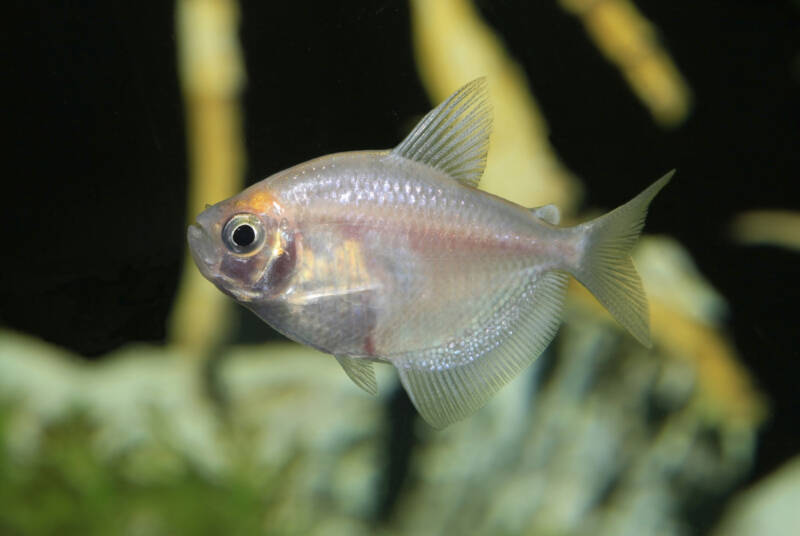
- Difficulty: Easy
- Temperament: Peaceful
- Diet: Omnivore
- Tank Size: 10 gal (38 l)
A genetic variant of the well-known black skirt tetra (Gymnocorymbus ternetzi), the white skirt is a striking sight when swimming in a group.
Their all-white coloration and oversized anal fins stand out against darker or heavily planted backdrops. They reach a length of two inches (5.1 cm) as adults.
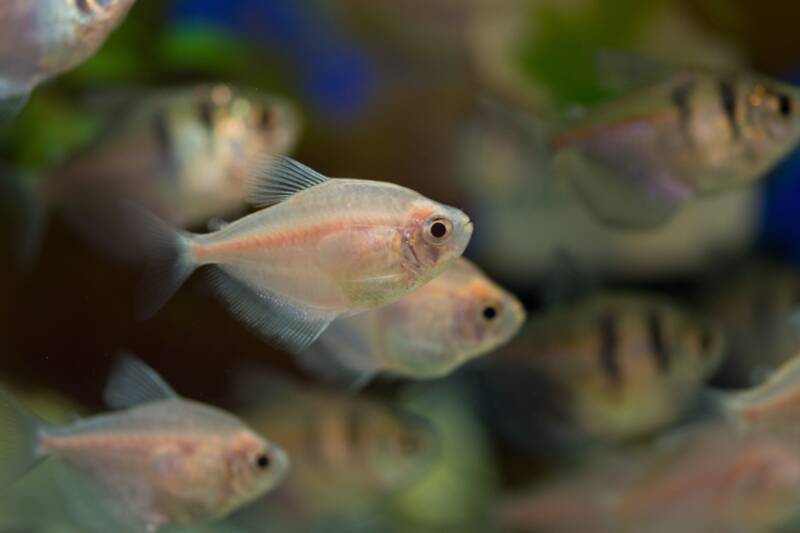
They are a peaceful South American species that can harmoniously live in a community tank with similarly sized fish. Avoid overly active tank mates and always keep white skirts in a group of at least six to allow shoaling.
The ease of care associated with this fish makes them ideal for beginner aquarists.
9. Black Phantom Tetra
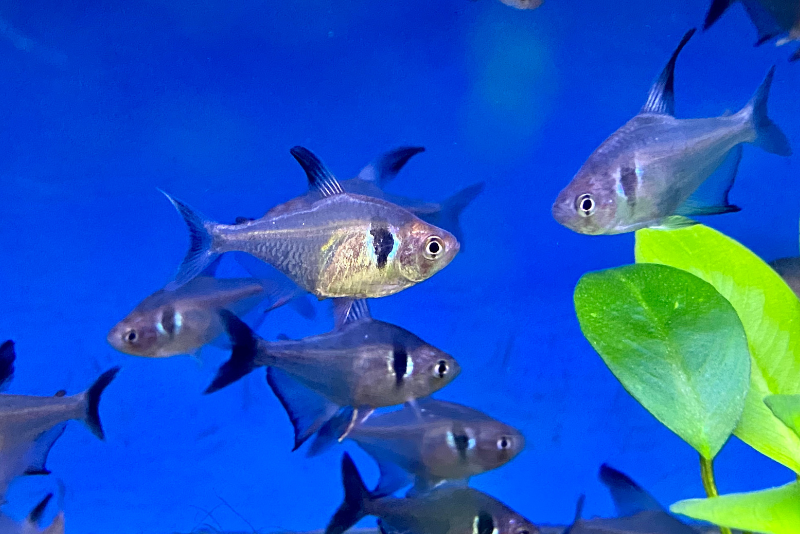
- Difficulty: moderate
- Temperament: peaceful
- Diet: omnivore
- Tank Size: 10 gal (38 l)
Black Phantom tetras (Megalamphodus megalopterus) earned their name from the black eyespots behind their gill covers. And you can find a similar pattern in the red phantom tetra.
Phantom males engage in battles for dominance within their schools. There’s no harm in allowing the fights to occur, and you won’t see injuries result.
The mirroring displays are one of the most exciting behaviors of these tetras. Black phantoms hang out in LARGE schools in their native rivers throughout central Brazil and Paraguay. As such, you’ll want to keep them in no less than a shoal of eight.
They WILL jump, so if you fail to provide sufficient cover (or numbers), monitor the area around the tank.
10. Redeye Tetra
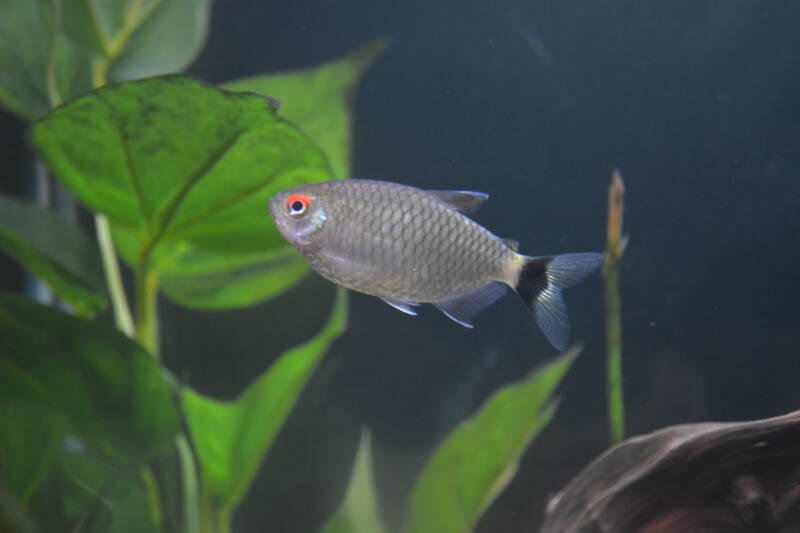
- Difficulty: easy
- Temperament: peaceful
- Diet: omnivore
- Tank Size: 20 gal (75 l)
This beautiful, silvery fish has black and white banding at the tail and, naturally, a prominent red band over the eye. When kept in a group of at least six, they are energetic and playful. (Moenkhausia sanctaefilomenae)
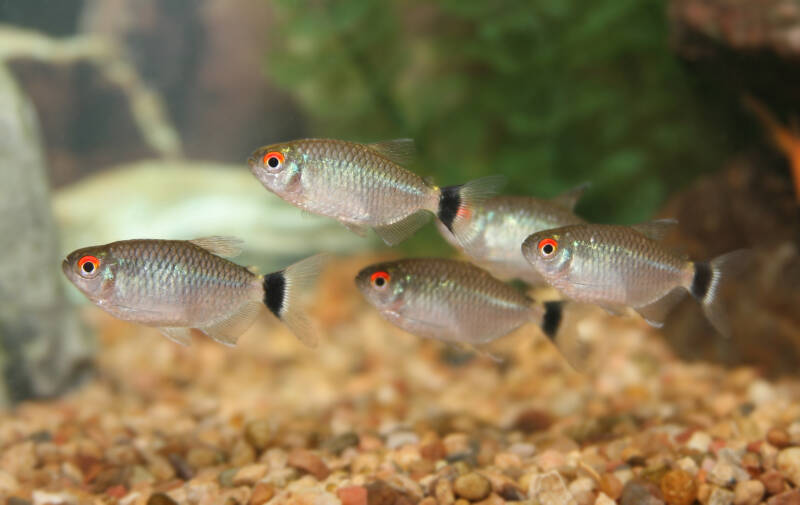
They are an excellent choice for beginning aquarists. These hardy fish tolerate a range of water conditions and do not require ultra-soft water as do other tetras.
Redeye tetras are easy to feed as well, happily accepting flake and dried foods, in addition, to live and frozen treats. Because they are larger fish, reaching three inches (7.6 cm) as adults, they can be kept with various species in a community tank.
11. Buenos Aires Tetra
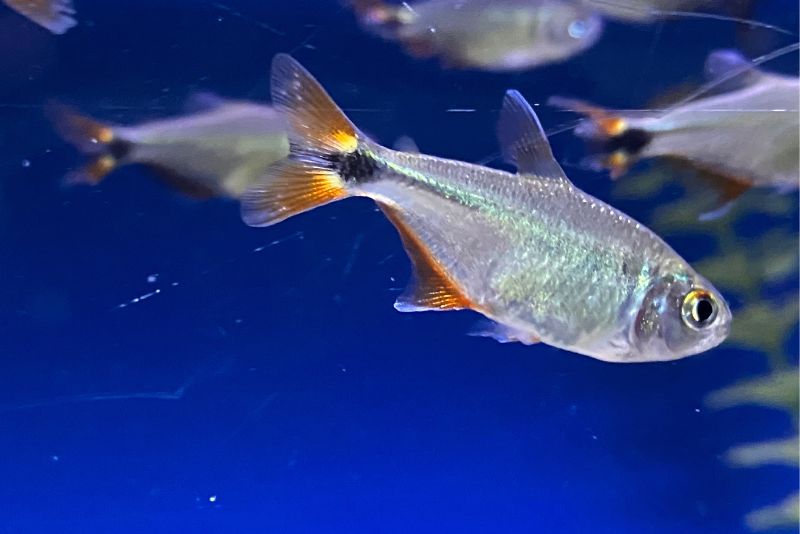
- Difficulty: easy
- Temperament: semi-aggressive
- Diet: omnivore
- Tank Size: 30 gal (113 l)
Buenos Aires tetras (Hyphessobrycon anisitsi) sport striking red fins that stand out against planted backgrounds. A little larger than the average tetra – 2.8 inches (7 cm) – they still don’t take up as much room as other colorful freshwater fish.
Unlike most other types of tetras, Buenos Aires tetras have dominance issues. They nip slower tank mates to assert themselves.
You can either choose faster fish for your aquarium or keep a large enough school to occupy your tetras with territorial disputes.
Buenos Aires tetras differ from the rest of the tetra group in their temperature needs. They tolerate unheated tanks. If the water goes above 77°F (25°C ) for extended periods, they start struggling and become susceptible to infection.
12. Congo Tetra

- Difficulty: moderate
- Temperament: peaceful
- Diet: omnivore
- Tank Size: 40 gal (151 l)
Congo tetras (Phenacogrammus interruptus) hale from (you guessed it) the Congo River in Africa. Their large scales mix blue, yellow, red, and green.
Males have more vibrant coloration. These beautiful fish also sport long, flowing fins that make a charming addition to any aquarium.
On the larger size for tetras, Congo tetras reach 3 inches (7.6 cm) in length. Combined with the need for proper school size, you’ll need a little more space for this particular type of tetra.
Just watch any nippy tank mates with those fins. If you want to get the best colors out of your Congo tetras, try adding some quality protein variety into their diet. Live foods such as brine shrimp, bloodworms, Daphnia, and Tubifex will help keep those rainbow scales looking their best.
13. Ruby Tetra

- Difficulty: moderate
- Temperament: peaceful
- Diet: omnivore
- Tank Size: 10 gal (38 l)
The Ruby tetra (Axelrodia riesei) has a slender orange/red body, transparent fins with a hint of blue at the tips, and a dash of black at the base of the tail. This tiny fish reaches 1.6 inches (4 cm) in length and has a long lifespan of five to 10 years.
Its size makes it a tempting target for larger fish, so consider the ruby tetra for a single species or nano tank. Keep them in groups of at least six to 10 for them to feel comfortable.
Ruby tetras need more attention to water conditions than other tetras. They favor a blackwater setup with soft, slightly acidic water.
14. Blue Tetra
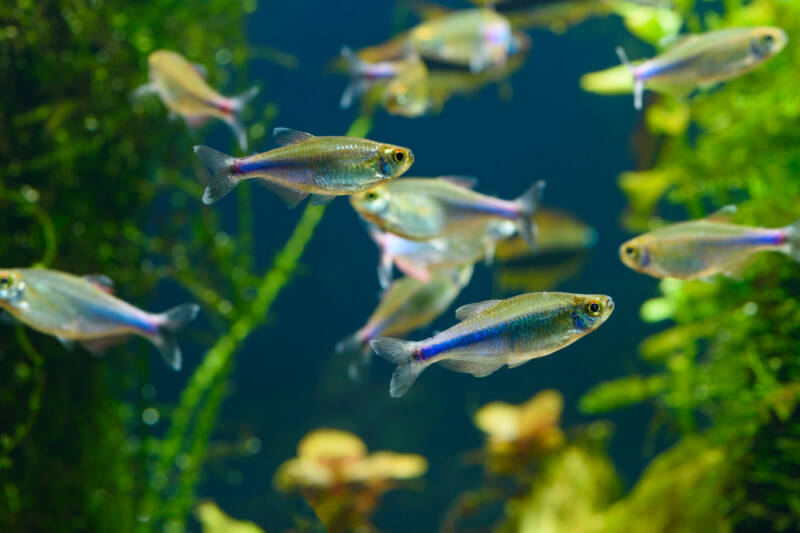
- Difficulty: easy
- Temperament: peaceful
- Diet: omnivore
- Tank Size: 20 gal (75 l)
Blue tetras (Boehlkea fredcochui) break the common tetra mold by having a single color. The body comes in either blue or purple, with darker saturation along the lateral line. However, if you catch them just so in the light, their natural iridescence shines.
Blue tetras fall into the average length of 2.3 inches (5.8 cm). Provided you keep their water quality pristine, you’ll get to enjoy them for about 3-4 years (not too shabby). Make sure you keep a school of at least six.
While blues are technically peaceful, they have some destructive behaviors.
If the tank’s overcrowded, they develop nipping behaviors. This goes double for any tank mates that have elongated fins.
So try to keep their stress level to a minimum and choose tank size appropriately.
15. Colombian Tetra
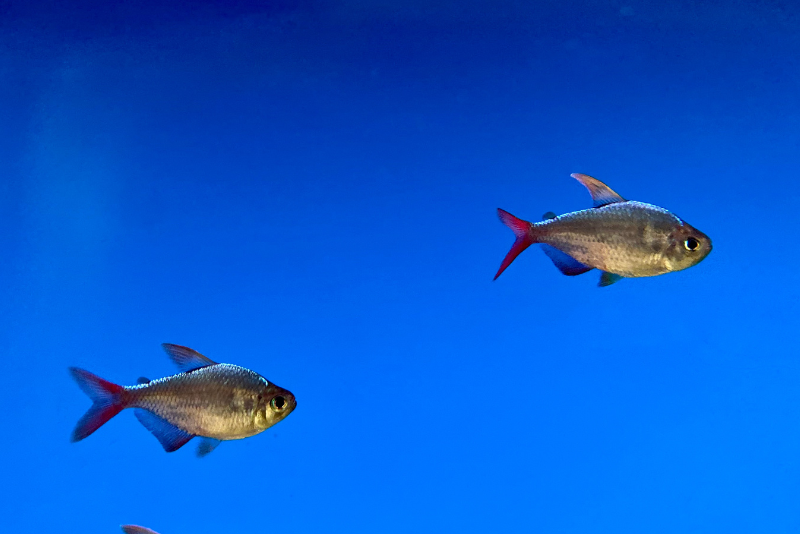
- Difficulty: easy
- Temperament: peaceful, but may bully smaller tank mates
- Diet: omnivore
- Tank Size: 20 gal (75 l)
Colombian tetras (Hyphessobrycon columbianus) are a sparkling silver color, with a hint of blue on the back and flashy red fins. Some adults have an orange hue to the top dorsal fin as well. They reach an adult length of just under 3 inches (7.5 cm). The Colombian tetra’s body shape is rounder in shape compared to other tetras, which allows them to ‘pop’ in the aquarium much more so.
This fish is hardy and quite active. As a school, they function well as dither fish in a community of similarly sized species, even more aggressive ones, such as small cichlids or barbs. Be cautious when pairing them with smaller fish.
They are enthusiastic feeders. Although they favor meaty foods, they will readily accept many commercial fish foods as well. Take care if there are slow eaters in the tank, as the tetras may outcompete them.
16. Neon Tetra
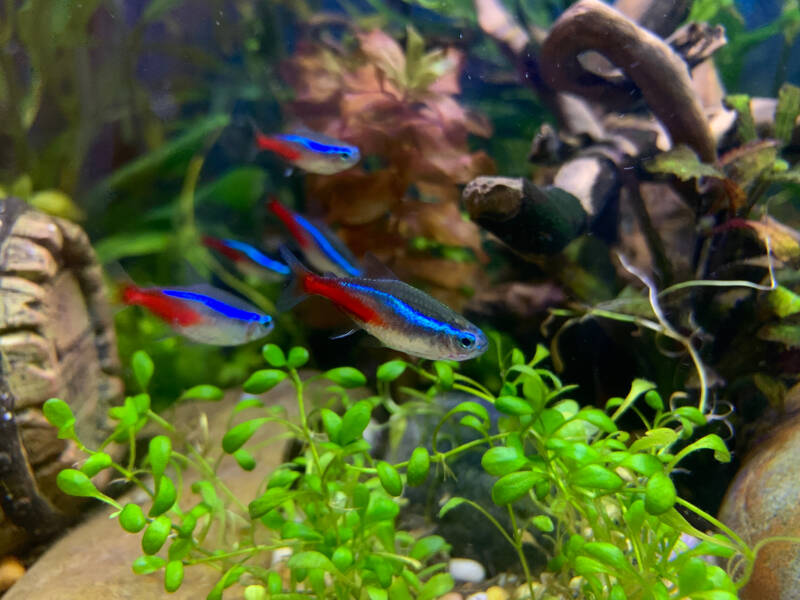
- Difficulty: easy
- Temperament: peaceful
- Diet: omnivore
- Tank Size: 15 gal (56 l)
Neon tetras (Paracheirodon innesi) are one of the most iconic members of the tetra group. Most aquarists have kept neons at one point or another.
They have the iconic silver line down their sides common to the Paracheirodon genus, with a smaller red splash beneath than cardinal tetras. Neons are small-sized for the tetra group, reaching 1.5 inches (4 cm) at full growth.
Their easy-going nature makes them the perfect choice for community tanks. Aquarists often pair them with other peaceful freshwater species.
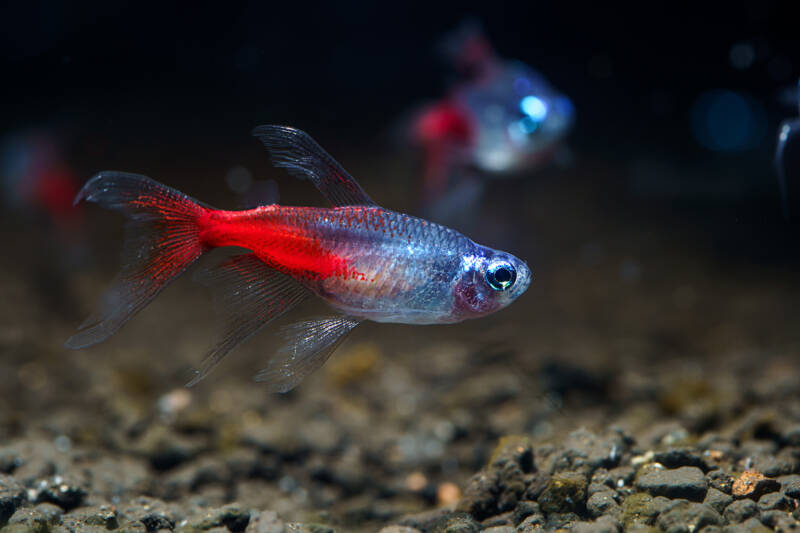
Beginning aquarists love neon tetras. They’re hardy little fish without demanding care needs. (Despite the fact a horrible disease got named after them) Provided you maintain proper water quality, they can live up to 10 years.
17. Cardinal Tetra
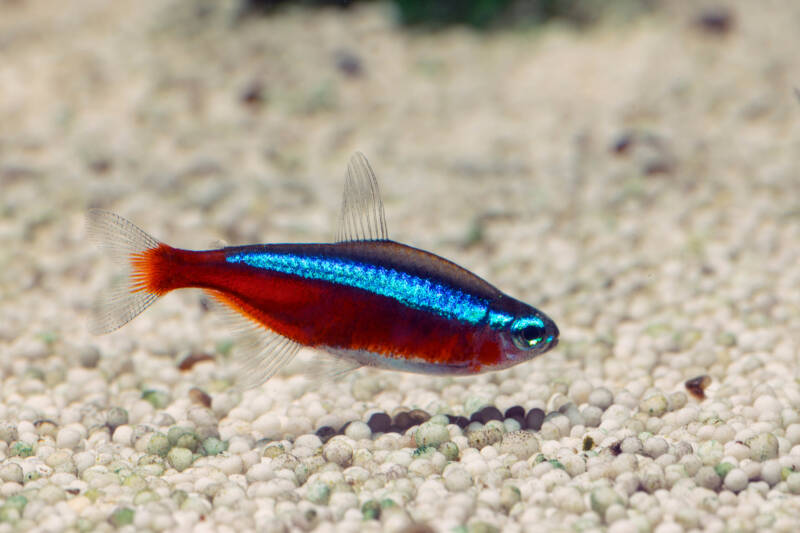
- Difficulty: easy
- Temperament: peaceful
- Diet: omnivore
- Tank Size: 10-20 gal (35-78 l)
No doubt these two tetras look strikingly similar, where they differ is the vibrant red strip extends the entire length of the body on a Cardinal tetra; where Neon tetras have a half-body red swoosh starting at the tail. When the light strikes that iconic line, these fish sparkle.
Cardinals fall on the smaller side of the tetra group. They come in around 2 inches (4 cm), though you may get a fish that grows a touch longer.
The shoaling instinct in this little fish is strong, so even if you’re only able to handle a small group, you’ll see them school. Therefore, it is recommended to have at least four fish per tank.
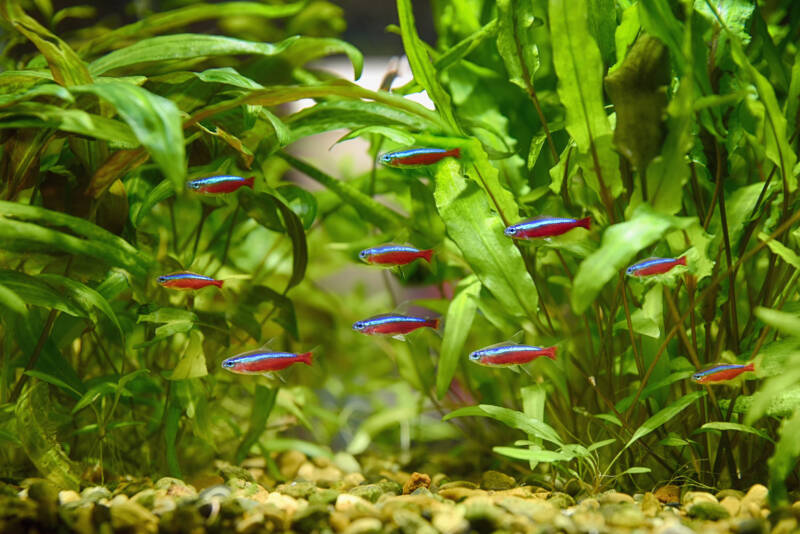
These iridescent fish are docile, active fish that are easy to care for. Set up the environment as a planted aquarium for optimal conditions as these fish love to swim in and out of aquatic plant leaves, and investigating all levels of the water column.
18. Black Neon Tetra
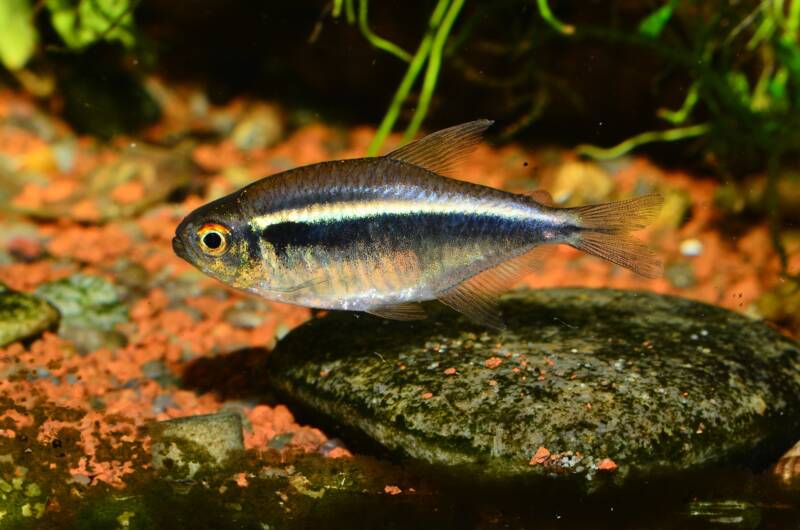
- Difficulty: easy
- Temperament: peaceful
- Diet: omnivore
- Tank Size: 20 gal (75 l)
The Black Neon tetra (Hyphessobrycon herbertaxelrodi) is a Brazilian native, with a silvery body with two prominent lines running the length of it: one a yellow/green and below it, black. Easy to care for, like their popular cousin the Neon tetra, however the Black Neon is significantly more muted, dark hues. This unique coloration allows them to blend into their native, brackish habitat full of dark, decaying vegetation.
This tetra is tiny, reaching 1.5 inches fully grown. Carefully select tank mates that will not consider this fish as food. Because they have small mouths, black neons require a mix of appropriately micro sized foods.
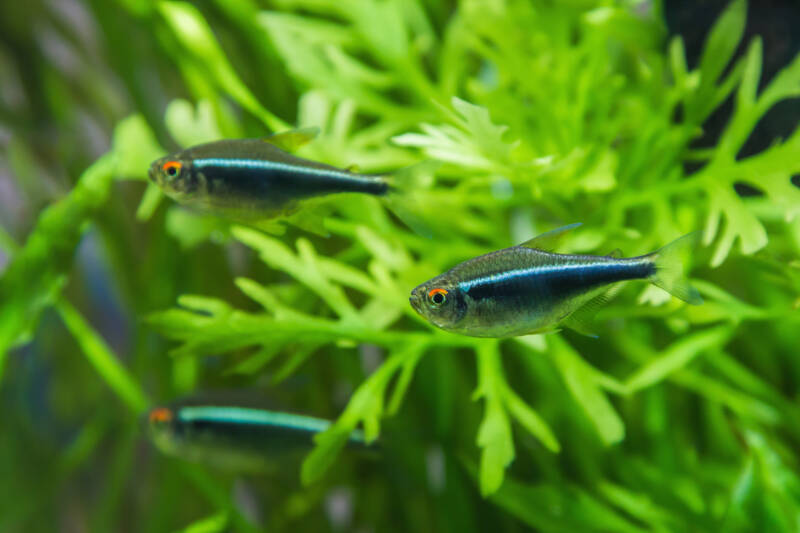
Black neon tetras are shoaling species that enjoy being in a group of six or more. Make sure the tank has plenty of swimming space. Quarantine this fish before placing them in a tank with others. Use a drip method to acclimate them slowly over the course of an hour.
They do prefer a slightly acidic tank of 5.0-7.5 pH, and a warmer water temperature.
19. Green Neon Tetra
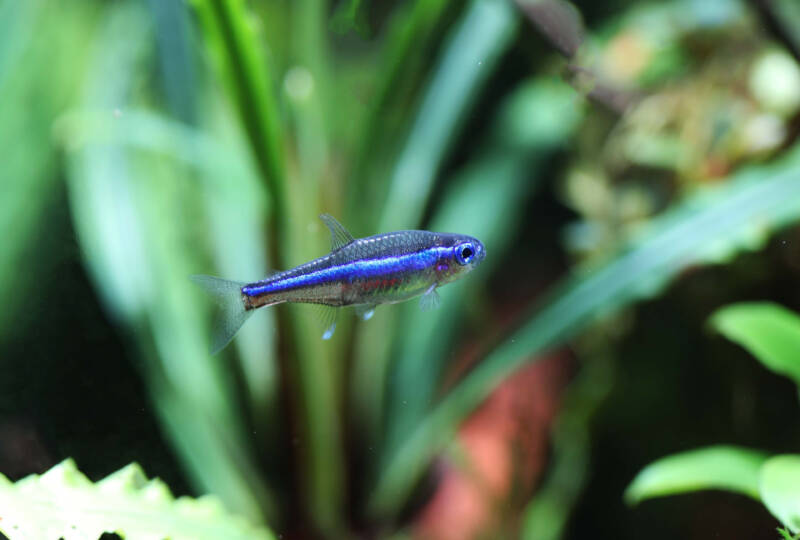
- Difficulty: easy
- Temperament: peaceful
- Diet: omnivore
- Tank Size: 20 gal (75 l)
The Green Neon tetra (Paracheirodon simulans) is often mistaken for the popular Neon tetra, with the Green Neon being slightly smaller and having subtle differences in coloration. These shoaling fish only reach around 1 inch in length (2.5 cm).
In the wild, they inhabit slower-moving, heavily vegetated blackwaters in South America. A similar aquarium setup with a sandy substrate will make them happiest. Keep the water acidic and very soft.
This fish is easy to care for but can be challenging to place in a community tank due to its small size. They are best kept in a single species aquarium in groups of at least eight.
20. Green Fire Tetra
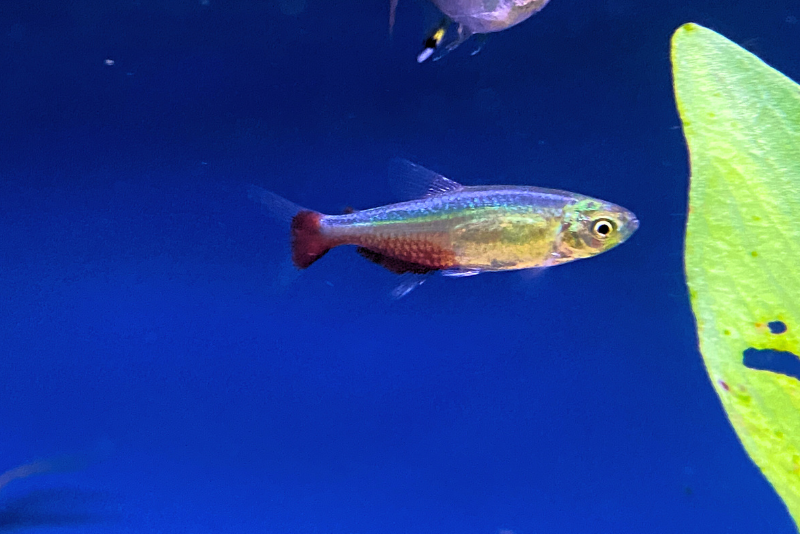
- Difficulty: easy
- Temperament: peaceful
- Diet: carnivore
- Tank Size: 10 gal (38 l)
The Green Fire Tetra (Aphyocharax rathbuni) is another stunning South American species with a glittering green body and bright splash of red on its belly and base of the tail. In many aquarium stores, this fish can be a bit rare and hard to source.
They show their best colors when kept in a school of at least six. An aquarium with plenty of hiding spaces and a darker substrate will further increase their comfort level.
Your carnivorous green fire is easy to feed. It needs a high protein diet and will accept frozen, freeze-dried, and live foods. While these fish are friendly and work well in a community tank, they can nip at the fins of slower swimming fish.
21. Candy Cane Tetra
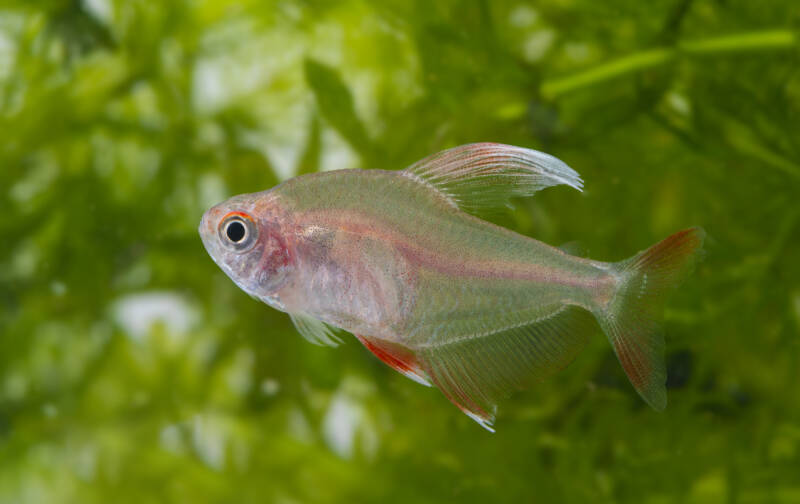
- Difficulty: moderate
- Temperament: peaceful
- Diet: omnivore
- Tank Size: 20 gal (75 l)
The Candy Cane’s (Hyphessobrycon bentosi) pink-hued body is adorned with transparent fins. These white-tipped fins curve gently backward and have splashes of red.
This two-inch long (5 cm) omnivore is a micro predator that needs a varied, balanced diet, including meaty foods.
Keep these fish in a well-maintained blackwater tank with a low current flow and dim lighting. They tolerate a range of water conditions as long as they are stable and the water is clean.
Candy cane tetras have the perfect temperament for community tanks, and their size allows them to pair with a wide variety of other peaceful species. However, avoid keeping them with shrimp.
22. Rosy Tetra
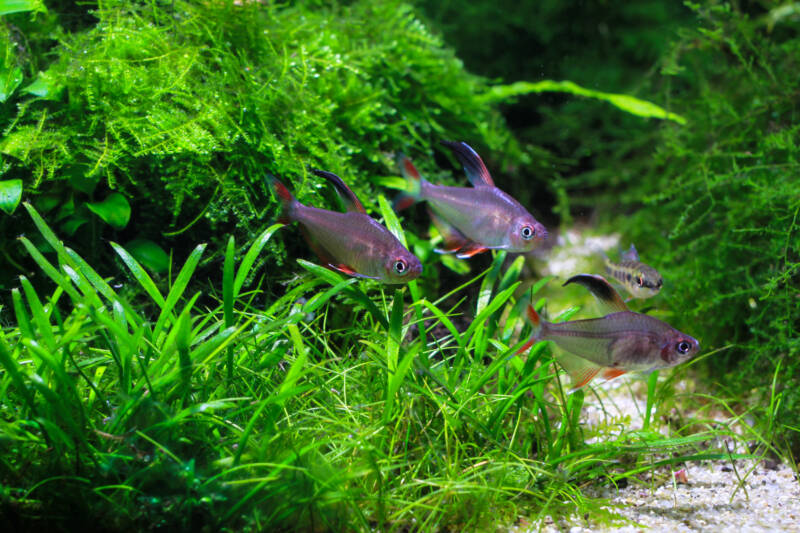
- Difficulty: easy
- Temperament: peaceful
- Diet: omnivore
- Tank Size: 20 gal (75 l)
Often mistaken for the Candy Cane tetra, the Rosy tetra (Hyphessobrycon rosaceus) has a darker, more salmon-colored body that is less transparent and its dorsal fin features a black marking.
The rosy tetra shines in a dimly lit aquarium with a dark substrate and plenty of plants. While they are hardy and adapt to various water conditions, do not keep them in hard water as their color may fade.
If not kept in a large group of six or more, these fish can show slight aggression and fin nipping. Avoid keeping them with slow swimming, long finned, or overly boisterous fish.
23. Toucan Tetra 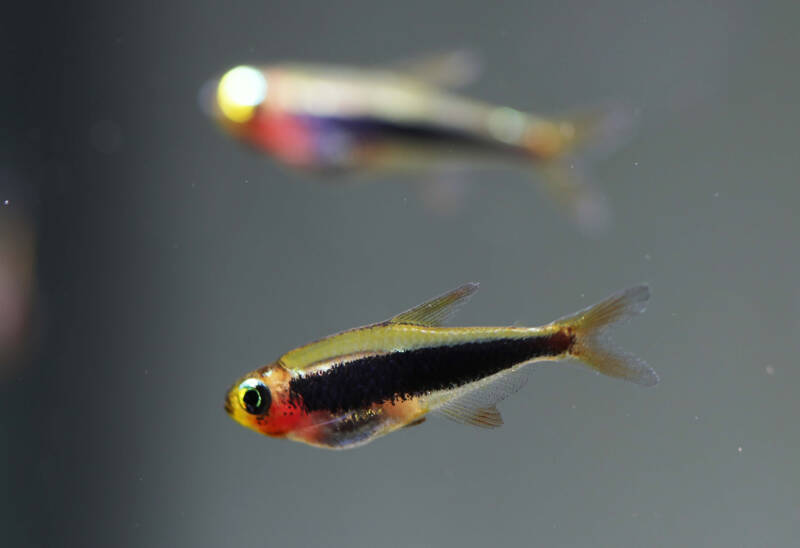
- Difficulty: moderate
- Temperament: peaceful
- Diet: omnivore
- Tank Size: 10 gal (38 l)
The Toucan tetra (Tucanoichthys tucano) is true to its namesake, with a colorful body of orange, blue, yellow, and white. Its oversized eyes and uniquely shaped fins complete the avian image.
This tiny, friendly fish hails from blackwater streams in Brazil and maxes out at only 0.8 inches (2 cm). They are a shoaling fish and enjoy living with others of their kind in groups of at least eight.
These fish are better suited to nano tanks as their small size makes them easy prey in a larger community tank. Introduce this species to a mature aquarium system with dim lighting and tinted waters.
24. Diamond Tetra

- Difficulty: easy
- Temperament: peaceful
- Diet: omnivore
- Tank Size: 20 gal (75 l)
Diamond tetras (Moenkhausia pittieri) don’t seem that impressive when you see them as juveniles. Once they transition to their adult coloration, though, you understand how they got their names.
Underlying shades of grey, black, and yellow mix with an iridescent scale to flash like the namesake gem.
Diamonds have a calm nature, and they do well in community tanks. Place them with other colorful tetras, and their shine REALLY pops.
You do need a school of at least eight to prevent unwanted nipping behavior, though. As far as care goes, diamond tetras are a cinch. They even hold their own against similar-sized cichlids.
If you want to try your hand at tetra breeding, this species is one of the easiest to manage, even for beginners.
25. Bloodfin Tetra

- Difficulty: easy
- Temperament: peaceful
- Diet: omnivore
- Tank Size: 30 gal (113 l)
Coming in at the longer end of the spectrum at 2 inches (5 cm), bloodfin tetras always stand out in a tank.
The vibrant crimson touches at the ends of their fins catch the eye as they dart around the tank. Put together in a proper school of at least six, and they really pop.
Bloodfin tetras (Aphyocharax anisitsi) prefer the upper regions of an aquarium. It’s the same part of the Paraná River they hang out in in the wild.
You WILL need to keep a tight lid in place to prevent accidental leaps for “freedom,” though. If they get startled, they’ll jump out.
They have a high tolerance for water conditions, and you MAY get away without a heater on your tank (depending on the other fish in the community). However, if you stick closer to the 80°F (26.6°C) temperature end of their preferences, you’ll get better color results.
26. Penguin Tetra

- Difficulty: easy
- Temperament: peaceful
- Diet: omnivore
- Tank Size: 20 gal (75 l)
At first glance, you may think the Penguin tetra (Thayeria boehlkei) gets its name from the black and silver coloration. However, similar patterns show up in plenty of other tetra species.
Nope – this tetra’s named for its habit of swimming in a slightly vertical pattern (unusual for fish).
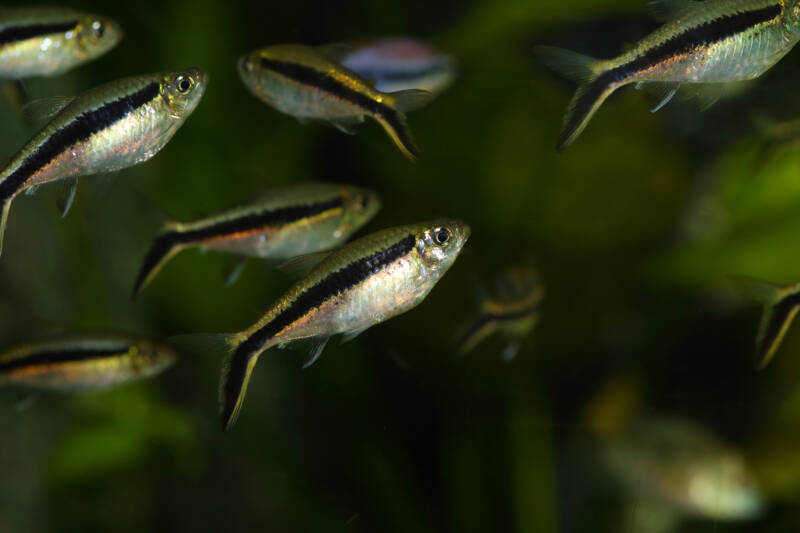
Penguins frequent the flood plains of the upper regions of the Amazon Basin.
There they feed on everything from worms and insects to floating plants. Of course, plenty of birds and reptiles feed on THEM, so they hang out in root systems for protection.
You’ll want to set up a school of at least five penguin tetras. This provides the stability and comfort they need. Otherwise, they do well in communities with tank mates of a similar size and temperament.
27. Flame Tetra

- Difficulty: easy
- Temperament: peaceful
- Diet: omnivore
- Tank Size: 10 gal (38 l)
Don’t confuse the Flame tetra (Hyphessobrycon flammeus) with the Ember tetra, even with their similar names. They’re about the same size, and they both share that transparent appearance.
However, Flame tetras have a much brighter red and orange coloration, with a few black stripes near the head.
Flames come from coastal rivers in Brazil. They prefer aquariums that mimic the same sandy-bottomed habitat. You don’t need to go overboard with the water current, though. A gentle, slow-moving current is sufficient for these little tetras.
Flame tetras, as with most types of tetra, prefer lower lighting conditions. This helps the colors stand out against the plants in your aquarium. So set your lights dim enough to keep the plants healthy, but not bright enough to mimic the surface of the sun.
28. Silvertip Tetra

- Difficulty: easy
- Temperament: peaceful
- Diet: omnivore
- Tank Size: 20 gal (75 l)
The South American Silvertip tetra (Hasemania nana) shines with a beautiful copper to yellow sheen over its semi-transparent body. Each fin looks as though it has been dipped in silver and a thick black bar covers the base of the tail.
They stay small, reaching only 1.2 inches (3 cm) in length. Their activity level and the need for a group of at least 10 to shoal necessitates a larger tank.
These hardy fish naturally inhabit various environments and water conditions. In an aquarium, they can adapt to an impressive range of water temperatures and pH levels, making it easy to pair them with other species.
29. Lemon Tetra

- Difficulty: easy
- Temperament: peaceful
- Diet: omnivore
- Tank Size: 20 gal (75 l)
When some aquarists pass tanks of Lemon tetras (Hyphessobrycon pulchripinnis) they ignore them. As juveniles, these triangular fish aren’t spectacular. It isn’t until they mature that the yellow shading on their fins comes in, explaining their name. Lemons also have brilliant red scales around their eyes.
Their coloring can help you gauge their health and happiness – something that sets them aside as good choices for novice aquarists. As they decline in health, those colors turn dull. It’s an early warning system that conditions, diet or something else might not be adequate.
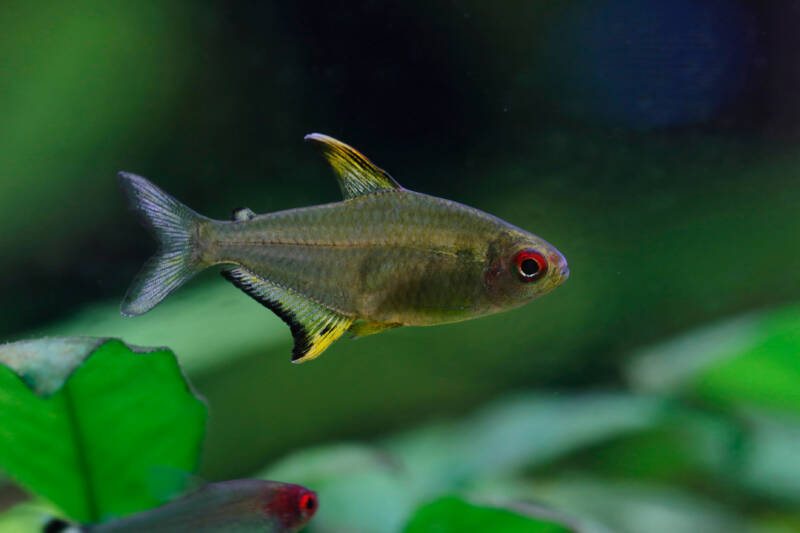
You’ll want to keep at least six lemon tetras together to satisfy their schooling needs.
More females than males will prevent aggression from breaking out, especially during the spawning season. Otherwise, they form a loose shoal in the aquarium.
30. GloFish® Tetra
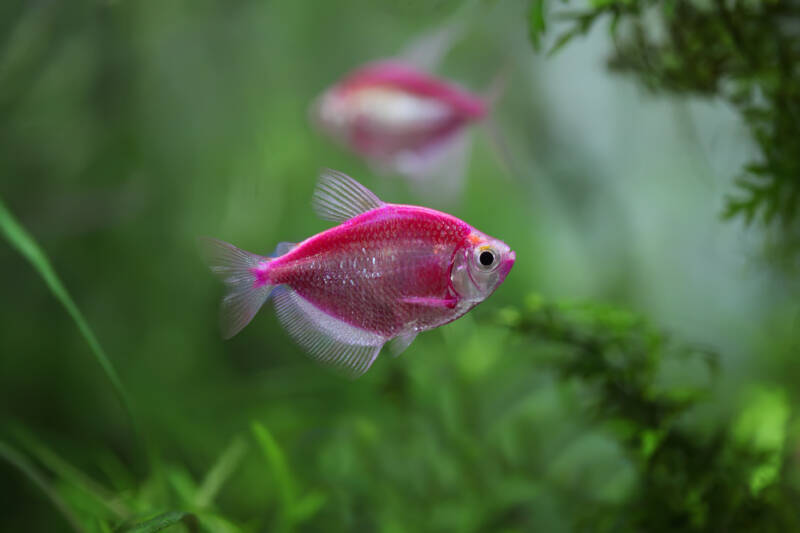
- Difficulty: easy
- Temperament: peaceful
- Diet: omnivore
- Tank Size: 5 gal (19 l)
GloFish® tetras come in six bright neon colors: pink, purple, orange, blue, green, and red. These modified fish inherit their glow genetically from their parents, rather than from dyes or injections.
They are schooling fish that should swim in a group of at least five with a minimum of one gallon of water per fish. Their peaceful nature makes them suitable for a community tank kept by beginner and experienced aquarists alike.
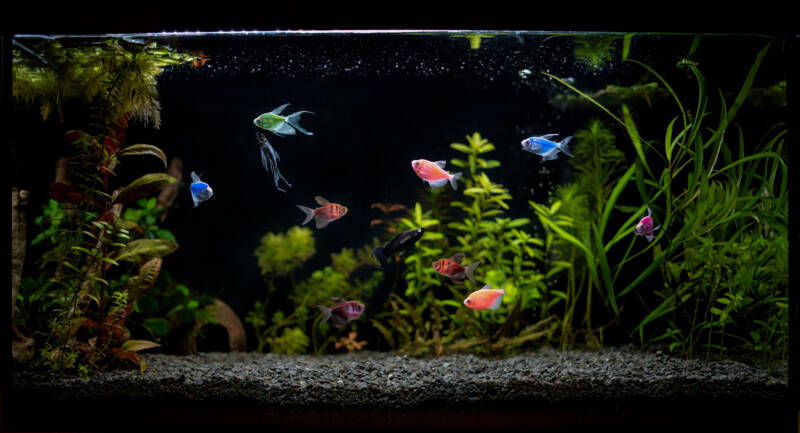
They like their water warm, in the range of 72 to 80°F (22 to 26°C), so invest in a heater and thermometer to keep your fish comfortable. Install a blue light to showcase their brilliant colors.
31. Glowlight Tetra

- Difficulty: easy
- Temperament: peaceful
- Diet: omnivore
- Tank Size: 10 gal (38 l)
Glowlight tetras (Hemigrammus erythrozonus) have the honor of being one of the most popular tetra species.
They have an iridescent stripe dividing their bodies that reminds people of the filament in a lightbulb. And when set against a dark substrate and dim lighting? It GLOWS.
And, of course, that’s the proper tank setup for these shy tetras. They swim in rivers throughout Guyana, which have a heavy tannin load. So they don’t do well with bright lighting schemes.
You’re better using floating plants to cut down on how much your lights put out. Glowlights need specific tank mates. They’re not brave enough to work with more predatory species.
And angelfish? Don’t mix the two. Angelfish LOVE glowlight tetras – as snacks. You’re asking for trouble if you combine them.
32. Loreto Tetra
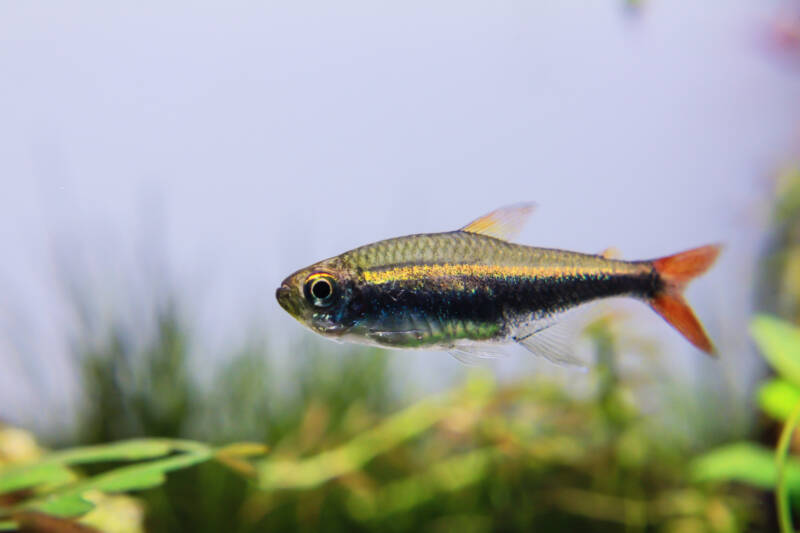
- Difficulty: moderate
- Temperament: peaceful
- Diet: omnivore
- Tank Size: 15 gal (57 l)
The Loreto tetra’s (Hyphessobrycon loretoensis) silvery body features a thick, dark stripe that runs from head to tail. A thin, golden line tops this one, making for a beautiful contrast. They have transparent fins with splashes of red and white.
Keep your peaceful Loreto tetras in groups of at least eight to see their best behaviors. Allow plenty of space in the tank as well as hiding spots to give fish a break from time to time.
These highly active fish are more sensitive to changes in water parameters than other tetras on this list. They are best for an aquarist with some experience.
33. Long-Finned Tetra
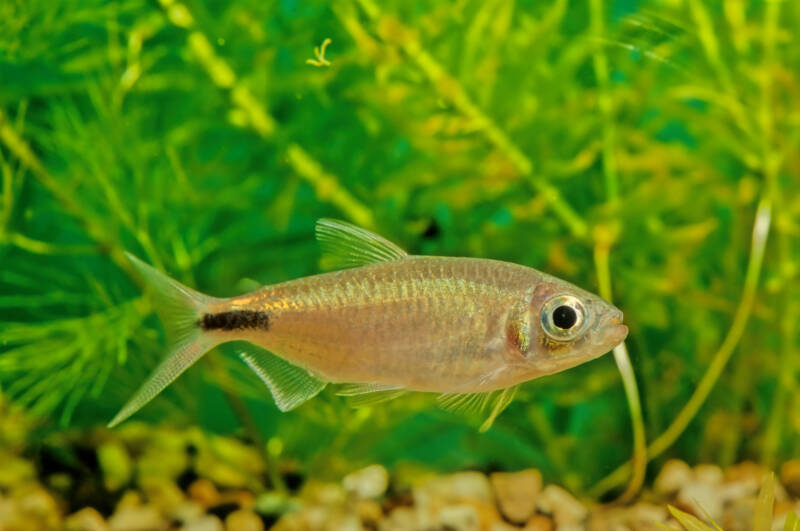
- Difficulty: moderate
- Temperament: peaceful
- Diet: omnivore
- Tank Size: 55 gal (208 l)
This highly active tetra species works well in a community tank. Do not pair the Long-Finned tetra (Brycinus longipinnis) with slower-swimming species that will not tolerate the tetras’ activity levels.
Keep these fish in groups of at least six to encourage their natural shoaling behavior. They reach an adult length of 5 inches (13 cm) and require a larger tank.
These hardy fish inhabit a variety of natural environments, from quick moving streams to slower tributaries. They also tolerate water conditions ranging from freshwater to brackish.
Feeding these fish can be tricky at first, as they require high amounts of protein in their omnivorous diets.
34. Red-Base Tetra
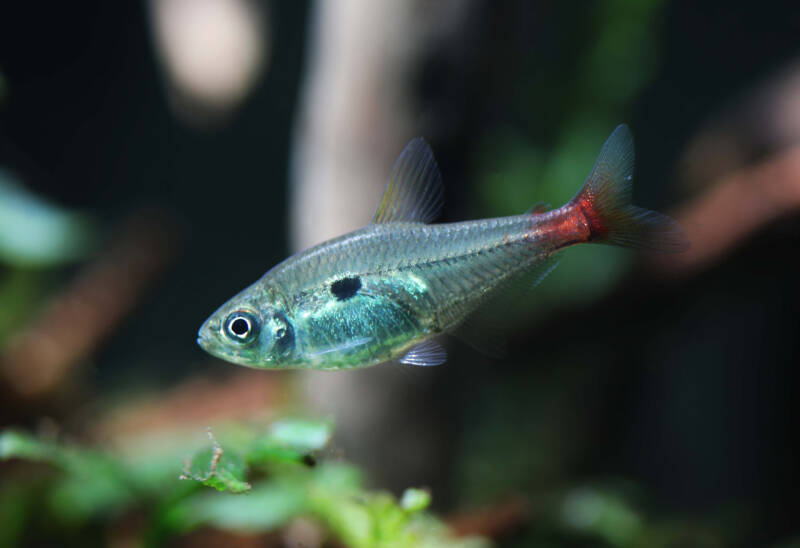
- Difficulty: easy
- Temperament: peaceful
- Diet: omnivore
- Tank Size: 15 gal (57 l)
The Red-Base tetra (Hemigrammus stictus) is native to South America and grows to a manageable 2.2 inches (5.6 cm) in length. Its silver body is accented by a splash of red at the base of the tail and a single black dot near its gills.
If you would rather not grow aquatic plants, then the red-base tetra may be for you. This species prefers tinted waters with driftwood features and dim lighting.
Peaceful and calm, this fish can coexist with other similarly tempered species but will not fare well with large, overly active fish. Red-base tetras prefer to shoal, so plan on keeping a group of at least six to 10.
35. Serpae Tetra
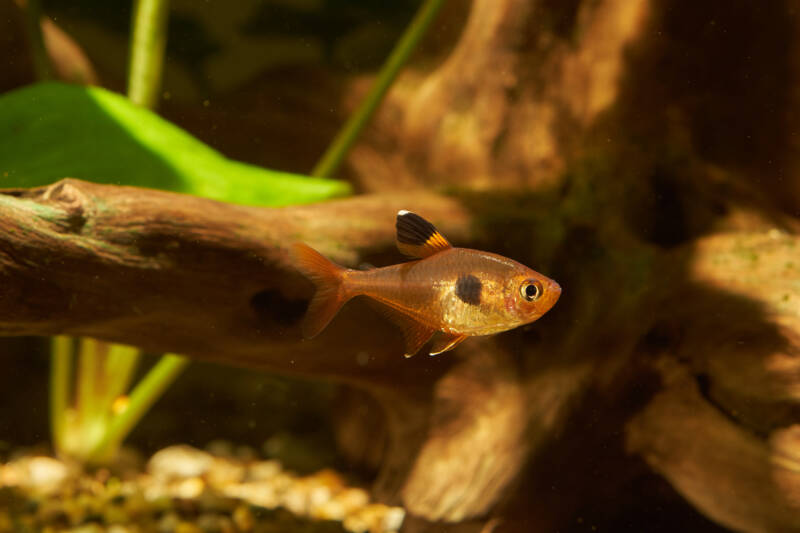
- Difficulty: easy
- Temperament: peaceful
- Diet: omnivore
- Tank Size: 20 gal (75 l)
People sometimes confuse Serpae tetras (Hyphessobrycon eques) with red phantom tetras. The two share a background of red scales, and they DO both have a black spot near the gills, but they’re not quite the same. Serpaes have more of a comma shape to their spot, and the red is softer in tone.
As Serpae tetras get older, their colors lose vibrancy. And the black spot? It takes on more of a grey-ish hue. It’s another important difference between Serpaes and red phantoms – though not one you’ll pick up on in the fish store (obviously).
Serpae tetras need to stay in schools of at least six.
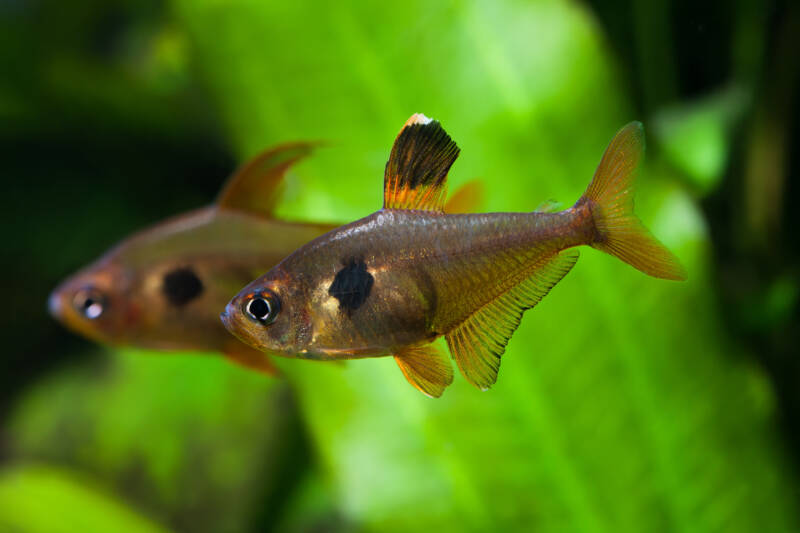
If you skimp on the shoal, they start to develop bad habits. You’ll find them nipping at fins – and not just on the other fish in the community. They’ll go after the fins of their own kind. It’s better to prevent this in the first place.
36. Red Phantom Tetra
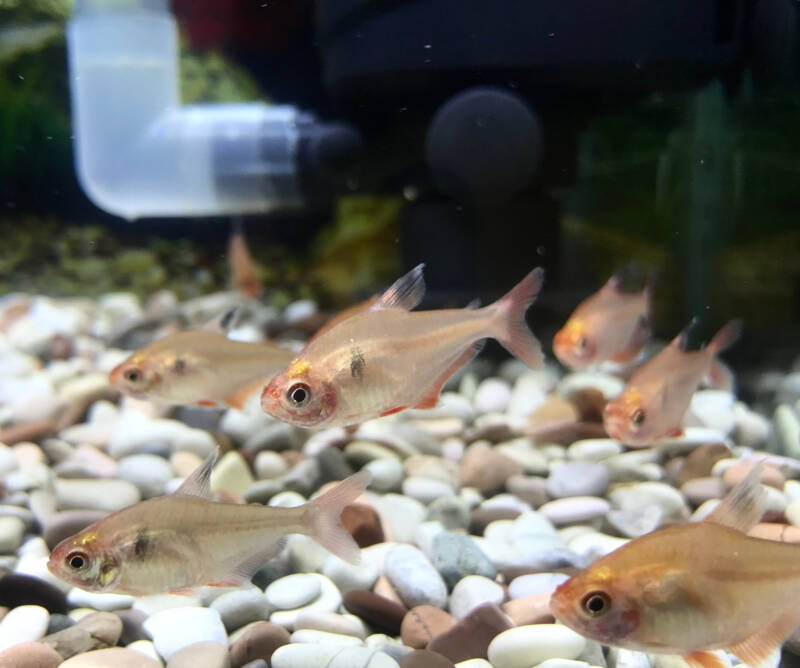
- Difficulty: easy
- Temperament: peaceful
- Diet: omnivore
- Tank Size: 15 gal (57 l) [30 gal (113 l) for larger groups]
For dramatic color in your fish tank, look to the Red Phantom tetra (Hyphessobrycon sweglesi). Their diamond-shaped bodies are bright red all over, and they have a distinctive black spot behind the gills.
This peaceful shoaling fish from South America is a fantastic addition to a community tank. Keep these active fish in groups of six to 10 for their most lively behavior.
Their tolerance for a range of water conditions makes them easy to care for as long as stable parameters are maintained. Set up their tank with a few plants, lower water flow, and plenty of swimming space for them to enjoy.
37. Bucktooth Tetra
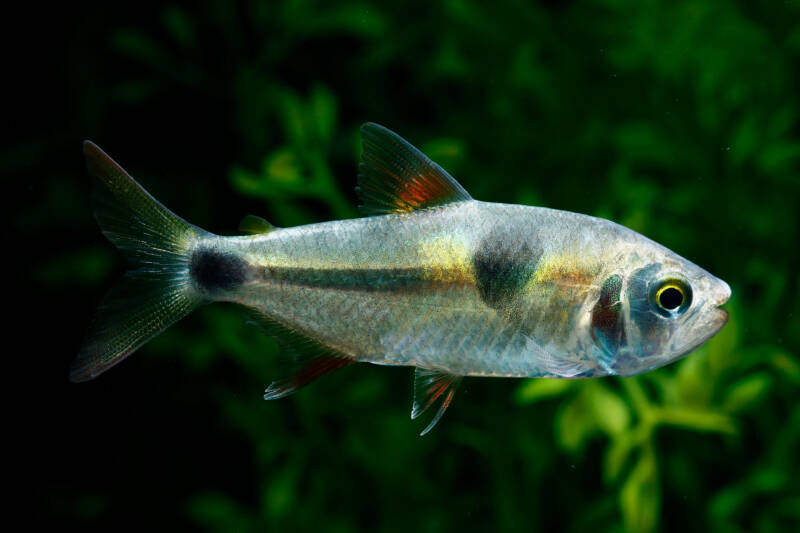
- Difficulty: moderate
- Temperament: aggressive
- Diet: carnivore
- Tank Size: 55 gal (208 l)
The Bucktooth tetra’s (Exodon paradoxus) base color is a metallic silver, with hints of red, green, and yellow. They have one dark spot behind the gills and one at the base of the tail.
The mouth and teeth of this predatory fish are positioned and shaped to facilitate their feeding method. This South American species hunts in groups, swarming prey and eating off the scales. This behavior makes them candidates for a single-species tank.
These are bigger tetras that reach four to 5 inches (10 to 13 cm) in length. Keep them in a sizable group of at least 12 in a large tank to spread out aggression.
38. Vampire Tetra
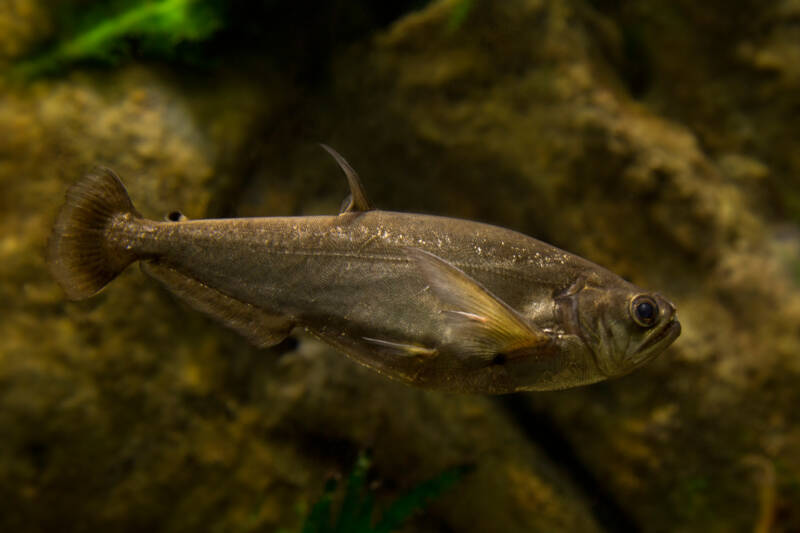
- Difficulty: difficult
- Temperament: peaceful, but predatory toward anything it can fit in its mouth
- Diet: carnivore
- Tank Size: 500 gal (1893 l)
Vampire fish (Hydrolycus scomberoides) have sleek gun-metal silver bodies and a mouth full of intimidating teeth, including two elongated fangs on its lower jaw. This fish is large for a typical home aquarium, reaching 10 to 12 inches (25 to 30 cm) fully grown.
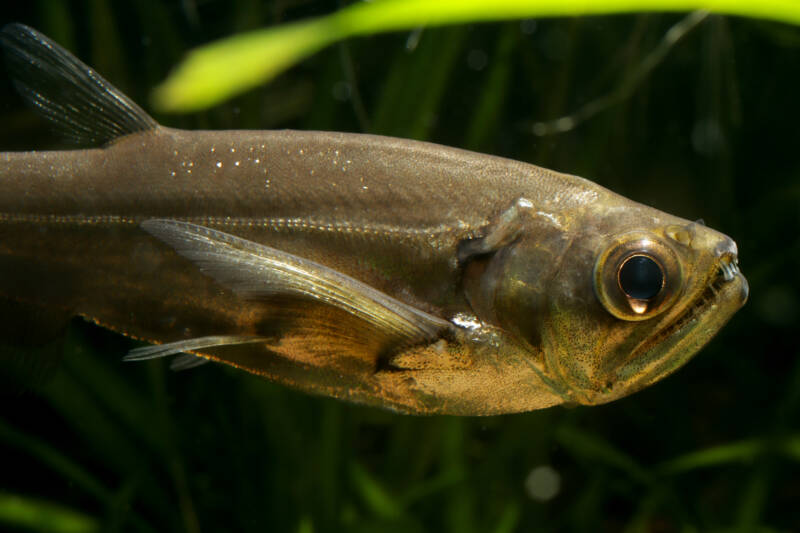
If you have the space, Vampire tetras can be kept in a group of three with other similarly sized, peaceful species. Their tank should be minimally decorated, highly oxygenated, and well filtered.
It can be challenging to feed vampire tetras. They are carnivorous fish eaters that actively hunt live prey. They must be fed the same in captivity unless they are trained to accept other foods.
39. Mexican Tetra/Blind Cave Tetra

- Difficulty: Easy
- Temperament: Peaceful
- Diet: Omnivore
- Tank Size: 20 gal (75 l)
While you won’t see any unique colors or patterns in Mexican tetras, (Astyanax mexicanus) they’re some of the group’s most notable members.
These little pinkish fish are a blind cavefish! And they’re growing more and more popular with aquarists due to the sheer uniqueness, and honors of saying “I own a blind fish”.
Two types of Mexican tetras exist: one with eyes and one without.
They’re from the same species, but one ends up exposed to sunlight and develops eyes. The other? It inhabits caves where there’s no sunlight and so no need for eyes.
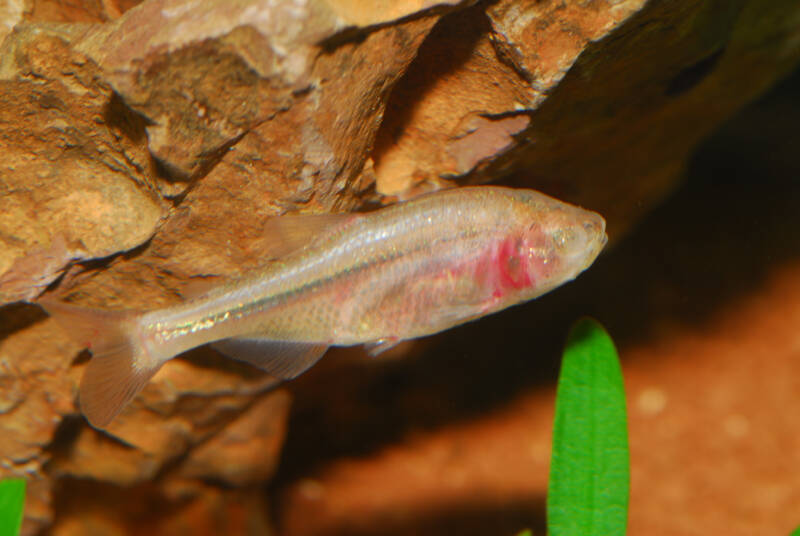
Either type does well in a community aquarium without a problem. Without sight, they use their sense of smell and lateral line to the FULLEST advantage.
And they’ll eat anything they get their teeth on; they’re ravenous. Once they figure out where the food is, other fish better watch out!
Tetra Fish Tank Setup
Tetras in the wild occupy lakes, ponds, rivers, and wetlands. The basins for these systems often feature deep beds of leaf litter from the surrounding forests.
Consider adding Indian almond leaves (or any dark, dried leaf litter) to your substrate to mimic the natural habitat.
All tetras are active swimmers. You’ll need a high-quality filter to provide a medium to fast water current to mimic the streamflow they’d find in their home region. HOB filters are your best option.
Aquarists get drawn to tetras due to the variety of colors and patterns. Nothing helps those colors stand out better than live aquarium plants.
Luckily, while tetras appreciate foliage in their aquariums, they aren’t prone to devour the greenery the way other omnivorous fish species might.
Top choices for tetra decorations include:
- Anacharis
- Anubias
- Amazon sword
- Brazilian pennywort
- Java fern.
Water Parameters

Tetras are primarily tropical fish. As such, you’ll need a quality heater to keep your aquarium at the appropriate temperature.
Otherwise, make sure you research your species carefully for their specific water quality needs.
| Species | Temperature | pH | Hardness | Nitrites | Ammonia | Nitrates |
| Black phantom tetra | 72-82°F
(22-28°C) |
6.0-7.5 | Up to 18 dH | 0 ppm | 0 ppm | <40ppm |
| Black widow tetra | 75-80°F
(24-26°C) |
6.0-7.5 | 5-20 dH | 0 ppm | 0 ppm | <40 ppm |
| Bleeding heart tetra | 72-80°F
(22-26°C) |
6.0-6.5 | 4-8 dH | 0 ppm | 0 ppm | <40 ppm |
| Bloodfin tetra | 70-80F
(22.2-26.6C) |
6.0-8.0 | 3-21 dH | 0 ppm | 0 ppm | <40 ppm |
| Blue tetra | 72-82°F
(22-28°C) |
5.5-7.0 | 5-12 dH | 0 ppm | 0 ppm | <40 ppm |
| Buenos Aires tetra | 64-77°F
(18-25°C) |
5.5-8.5 | 1-20 dH | 0 ppm | 0 ppm | <40 ppm |
| Cardinal tetra | 73-81°F
(23-27°C) |
3.5-7.5 | 1-12 dH | 0 ppm | 0 ppm | <40 ppm |
| Congo tetra | 73-82°F
(23-28°C) |
6.0-7.5 | 3-18 dH | 0 ppm | 0 ppm | <40 ppm |
| Diamond tetra | 72-82°F
(22-28°C) |
5.5-7.0 | 2-15 dH | 0 ppm | 0 ppm | <40 ppm |
| Ember tetra | 68-82°F
(20-28°C) |
5.0-7.0 | 1-10 dH | 0 ppm | 0 ppm | <40 ppm |
| Emperor tetra | 73-81°F
(23-27°C) |
5.0-7.8 | 5-25 dH | 0 ppm | 0 ppm | <40 ppm |
| Flame tetra | 72-82°F
(22-28°C) |
5.8-7.8 | 5-20dH | 0ppm | 0ppm | <40ppm |
| Glowlight tetra | 74-82°F
(23-28°C) |
5.8-7.5 | Up to 15 dH | 0 ppm | 0 ppm | <40 ppm |
| Lemon tetra | 72-82°F
(22-28°C) |
5.5-8.0 | 3-20 dH | 0 ppm | 0 ppm | <40 ppm |
| Mexican tetra | 68-77°F
(20-25°C) |
6.0-7.5 | 30 dH | 0 ppm | 0 ppm | <40 ppm |
| Neon tetra | 70-82F
(21.1-27.7C) |
4.0-7.5 | 1-12 dH | 0 ppm | 0 ppm | <40 ppm |
| Penguin tetra | 72-82F
(22-28°C) |
6.0-8.0 | 5-20 dH | 0 ppm | 0 ppm | <40 ppm |
| Rummy nose tetra | 76-80°F
(24-27°C) |
5.5-7.0 | 2-15 dH | 0 ppm | 0 ppm | <40 ppm |
| Serpae tetra | 72-79°F
(22-26°C) |
5.0-7.8 | 5-25 dH | 0 ppm | 0 ppm | <40 ppm |
| X-ray tetra | 75-82°F
(24-28°C) |
6.0-8.0 | Up to 20 dH | 0 ppm | 0 ppm | <40 ppm |
Tetras have a particular sensitivity to ammonia:
- Their colors start to bleach
- They begin breathing more rapidly.
If you notice either sign, check your water quality immediately so you can begin addressing the problem.
Tank Mates
Unlike cichlids or freshwater sharks, tetras are one of the fish groups that play together nicely.
You can even combine types from different regions without problems. This allows you to create as colorful an aquarium as possible.
If you want to add variety to your community tank, you have plenty of options.
Tetras have peaceful temperaments, making them ideal tank mates for most similar-sized fish. Choosing fish that share the same diet makes your work a little easier:
For the larger types of tetra, consider pairing them with one of the following:
- Corydoras
- Danios
- Discus
- Dwarf cichlids.
No matter your choice, try to find complementary colors. You want the patterns and shine of your tetras to stand out.
The more colorful your aquarium, the better. And there are plenty of tropical fish options out there with peaceful natures.
Neon Tetra Disease
Despite the name, neon tetra disease holds the potential to infect ANY fish. (Tetras just get overrepresentation)
The disease comes from the microsporidian, Pleistophora hyphessobryconis, which is a parasite that produces spores. This disease moves quickly through aquariums.
Infection results from the ingestion of food contaminated with spores, or ingestion of a fish that succumbed to the disease.
The parasite consumes fish from the inside out, burrowing through the intestines and encysting in muscular tissue.
Signs of the disease progress in this order:
- Unusual behaviors, particularly failure to follow typical tetra schooling behavior. (This results from the pain of the parasite burrowing into the intestinal tract)
- The bright colors slowly leach away from the body. You’ll notice one patch disappear, then gradually the rest of the body follows.
- The formation and growth of the cysts cause lumps to form.
- The resulting pain and lumps end in trouble with standard swimming patterns.
- Advanced cases result in an abnormal curvature of the tetra’s spine.
As the parasite gains hold, secondary infections such as fin rot or bloating can gain hold.
Treatment
There’s no cure for neon tetra disease. Your best bet is to recognize the signs as early as possible and remove infected fish from the aquarium before the spores hit the water.
Euthanasia is the kindest option for those fish already affected. Be sure to dispose of it in an ethical way.
If you have neon tetra disease in your tank, swift action SHOULD protect the remainder of your fish.
Having an isolation aquarium to keep ill fish in helps slow any infection process. Remember, neon tetra disease spreads through the ingestion of dead tissue.
Spores can stay in a tank for SIX MONTHS! So if you encounter this nasty parasite, thoroughly clean and disinfect your tank.
Make sure you quarantine your healthy fish for at least that long – just to be on the safe side.
Tetra Overload
With over 150 species of tetra to choose from, aquarists get spoiled for choice. These little fish are relatively undemanding in their care and peaceful additions to community tanks.
With so many color and pattern choices, you’re sure to find one that appeals to your sensibilities.
Have you fallen for the tetras’ charm? Which color or pattern is your favorite?
Let us know here!

